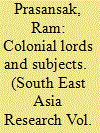|
|
|
Sort Order |
|
|
|
Items / Page
|
|
|
|
|
|
|
| Srl | Item |
| 1 |
ID:
142847


|
|
|
|
|
| Summary/Abstract |
This paper exposes colonial remnants in modern-day Thailand through a postcolonial materialist analysis of Lao Khamhom's 'Dust Underfoot'. Revolving around the conflict between a minor member of the Bangkok royalty and a Khmu forest worker in northern Thailand, this short story sheds light on Siam's semicolonial conditions created at the turn of the nineteenth century. Though nominally independent, Siam was subject to the capitalist world economy. This was clearly discernible in the British-dominated teak industry in the North. Siam, however, was not so much a victim as a collaborator and beneficiary of colonial capitalism. The Siamese monarchy sustained British capital by recruiting Khmu ethnic subjects into an exploitable labour force for timber production. This collaboration with the British enabled the monarchy to consolidate its economic, political and cultural power over its population. 'Dust Underfoot' underscores Siam's colonial legacies by critiquing the continued exploitation of the Khmu and other lumbermen by the emerging Thai sakdina-turned-bourgeois class in the 1950s. Following in the footsteps of the West, these royal elites viewed themselves as civilized rulers lording it over their 'savage' subjects. This paper also discusses the story as a seditious challenge to the hegemonic Buddhist 'god–king' discourse and translational process that underpins the foundation of the rule of the Thai monarchy.
|
|
|
|
|
|
|
|
|
|
|
|
|
|
|
|
| 2 |
ID:
142849


|
|
|
|
|
| Summary/Abstract |
This article investigates cross-cultural encounters from the point of view of a local man who tries to gain the upper hand in power negotiations in the context of tourism. Through titillating narratives, he constructs 'white women' as 'loose', a stereotype which remains prevalent in Thai male perceptions of Western women in the twenty-first century. The article looks at selected semi-fiction from the 1972 collection Kai-phi Bangkok chut 1 (Bangkok Unlicensed Guide Collection 1) by Ta Tha-it in its capacity as a representative of the 'lowbrow' genre of 'male writing for male reading'. Exploring the narratives of sexual encounters between a local tour guide and Western women, it examines the sexualization of the farang (Western) body as a strategy for 'fun, games and gains' in cross-cultural sexual encounters. In the three stories discussed, the sexualized farang bodies turn out to be homosexual, masochistic and aged respectively, while the Thai body is hetero-normative, young and virile. The entire collection from which this analysis is drawn was composed in the 1970s against the backdrop of Cold War Thailand as an emerging tourist destination for US soldiers in Indochina and of the rise of international tourism in Thailand.
|
|
|
|
|
|
|
|
|
|
|
|
|
|
|
|
| 3 |
ID:
089372


|
|
|
|
|
| Publication |
2009.
|
| Summary/Abstract |
The Thai literary canon identifies three novels published around 1929 as the first authentic Thai novels. This pronouncement elides the importance of novels published before that date. Because literary scholars focus their teaching, writing and research on novels defined by the canon, lesser-known works have been overlooked or ignored. The current Thai canon obfuscates literary transmission, in particular, the significance of pre-1929 compositions. In this essay, three novels - Mae Wan's Khwam phayabat (1902), Khru Liam's Khwam mai phayabat (1915) and Nang neramid (1916) - are selected to show that these early compositions represent important genres of novels that should be considered for the canon, even though they are seen as less than 'authentic' Thai. This paper examines the three novels through the lens of critical, translation and postcolonial theories. It is a study of vernacularisation, authenticity, hybridity, mimesis, and bi-culturalism.
|
|
|
|
|
|
|
|
|
|
|
|
|
|
|
|
| 4 |
ID:
142846


|
|
|
|
|
| Summary/Abstract |
This article re-examines the significance of Senee Saowaphong’s canonical Thai novel Peesart (The Spectre) in two key ways: by locating this work in the context of the rapid economic and social changes that took place in Thailand after the Second World War, and by identifying the modernist impulse as an underlying novelistic structure that forms and informs the clashes between the aristocrats and the commoners and between the urban and the rural. Employing Bhabha’s concept of hybridity and Anderson’s double provincialism, the article rereads the novel’s protagonist, Sai Seema, an iconic hero of the 1970s Thai student movement, as a hybrid figure. It is the ambivalence and undecidability of this character that destabilizes and subverts the power and authority of Bangkok elites in the text.
|
|
|
|
|
|
|
|
|
|
|
|
|
|
|
|
|
|
|
|
|